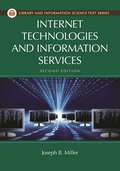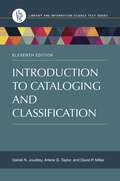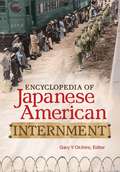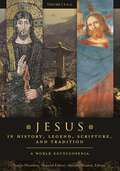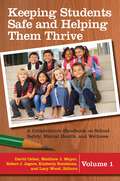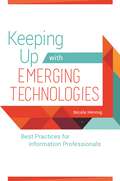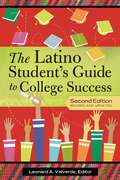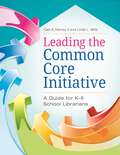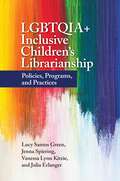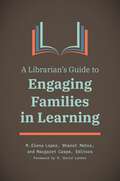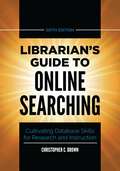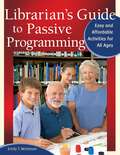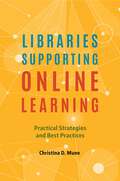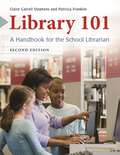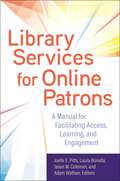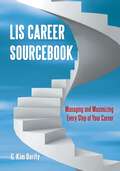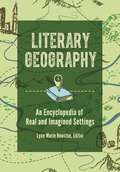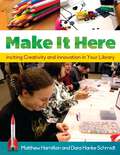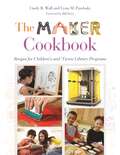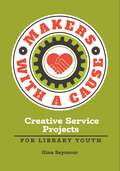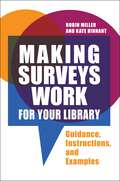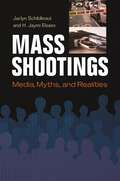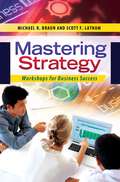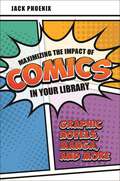- Table View
- List View
Internet Technologies and Information Services (Library and Information Science Text Series)
by Joseph B. MillerThe Internet has enabled the convergence of all things information-related. This book provides essential, foundational knowledge of the application of Internet and web technologies in the information and library professions.Internet Technologies and Information Services: Second Edition is a vital asset to students preparing for careers in library and information science and provides expanded coverage to important new developments while still covering Internet foundations. In addition to networking, the Internet, HTML, web design, web programming, XML, and web searching, this new edition covers additional topics such as cloud computing, content management systems, eBook technologies, mobile technologies and applications, relational database management systems (RDMS), open source software, and virtual private networking. It also provides information on virtualization and related systems, including desktop virtualization systems.With clear and simple explanations, the book helps students form a solid, basic IT knowledge that prepares them for more advanced studies in technology. It supplies an introductory history of the Internet and an examination of current trends with specific emphasis on how online information access affects the LIS fields. Author Joseph B. Miller, MSLS, explains Internet protocols and current broadband connectivity options; Internet security issues and steps to take to block threats; building the web with markup languages, programming, and content management systems; and elements of information access on the web: content formats, information retrieval, and Internet search.
Introduction to Cataloging and Classification (Library and Information Science Text Series)
by Daniel N. Joudrey Arlene G. Taylor David P. MillerA new edition of this best-selling textbook reintroduces the topic of library cataloging from a fresh, modern perspective.Not many books merit an eleventh edition, but this popular text does. Newly updated, Introduction to Cataloging and Classification provides an introduction to descriptive cataloging based on contemporary standards, explaining the basic tenets to readers without previous experience, as well as to those who merely want a better understanding of the process as it exists today. The text opens with the foundations of cataloging, then moves to specific details and subject matter such as Functional Requirements for Bibliographic Records (FRBR), Functional Requirements for Authority Data (FRAD), the International Cataloging Principles (ICP), and RDA. Unlike other texts, the book doesn't presume a close familiarity with the MARC bibliographic or authorities formats; ALA's Anglo-American Cataloging Rules, 2nd Edition, revised (AACR2R); or the International Standard Bibliographic Description (ISBD). Subject access to library materials is covered in sufficient depth to make the reader comfortable with the principles and practices of subject cataloging and classification. In addition, the book introduces MARC, BIBFRAME, and other approaches used to communicate and display bibliographic data. Discussions of formatting, presentation, and administrative issues complete the book; questions useful for review and study appear at the end of each chapter.
Encyclopedia of Japanese American Internment
by Gary Y. OkihiroThis book addresses the forced removal and confinement of Japanese Americans during World War II—a topic significant to all Americans, regardless of race or color.The internment of Japanese Americans was a violation of the Constitution and its guarantee of equal protection under the law—yet it was authorized by a presidential order, given substance by an act of Congress, and affirmed by the U.S. Supreme Court. Japanese internment is a topic that we as Americans cannot afford to forget or be ignorant of. This work spotlights an important subject that is often only described in a cursory fashion in general textbooks. It provides a comprehensive, accessible treatment of the events of Japanese American internment that includes topical, event, and biographical entries; a chronology and comprehensive bibliography; and primary documents that help bring the event to life for readers and promote inquiry and critical thinking.
Jesus in History, Legend, Scripture, and Tradition [2 volumes]: A World Encyclopedia [2 volumes]
by Antone Minard Leslie HouldenThis multifaceted work contextualizes Jesus in religion and culture by bringing together articles on folklore, history, literature, philosophy, popular culture, and theology.Many books have been written about Jesus, but this two-volume work takes a different approach than most. What sets it apart is that it emphasizes Jesus' lasting impact on world history and his legacy in the imagination over 2,000 years. Written as an introduction, the encyclopedia is equally suitable for Christians who wish to better understand the history and philosophy of their religion and for non-Christians who wish to grasp Christianity in its historical and social contexts.Alphabetically arranged entries cover representations of Jesus in the bible and the writings of key theologians, examining the essentials of philosophical and religious views across history. The set also includes hundreds of entries that reflect on the role Jesus has played in popular culture and contemporary vernacular religion—perspectives that are not usually placed alongside theology. Through the encyclopedia, students will see how artists, writers, philosophers, church figures, and others have imagined Jesus and been influenced by their perceptions of him. At the same time, primary documents will encourage students to compare and contrast ideas and evaluate arguments that have arisen over 20 centuries.
Keeping Students Safe and Helping Them Thrive [2 volumes]: A Collaborative Handbook on School Safety, Mental Health, and Wellness [2 volumes]
by David Osher, Matthew J. Mayer, Robert J. Jagers, Kimberly Kendziora, and Lacy WoodDetails the safety, mental health, and wellness issues in schools today and focuses on the interactions and collaborations needed among students, teachers, families, community members, and other professionals to foster the safety, learning, and well-being of all students.Safe schools and student well-being take a "village" of adults and students with varied interests, perspectives, and abilities collaborating to create caring, supportive, and academically productive schools. Schools are unofficial mental health care providers for children and youth who are placed at risk by social and economic circumstances and whose un- and under addressed needs can compromise teaching and learning. This handbook provides up-to-date information on how to promote safety, wellness, and mental health in a manner that can help draw the needed "village" together. It aligns research and practice to support effective collaboration—it provides information and tools for educators, administrators, policy makers, mental health and community organizations, families, parents, and students to join forces to promote and support school safety, student well-being, and student mental health. Chapters address school context, the dynamic nature of school communities and child development, and the importance of diversity and equity. Chapters provide in-depth understanding of why and how to improve safety, well-being, and mental health in a culturally responsive manner. They provide strategies and tools for planning, monitoring, and implementing change, methods for collaborating, and policy and practice guidance. They provide examples of successful and promising cross-system and cross-stakeholder collaborations. This handbook will interest students, scholars, faculty, and researchers in education, counseling, and psychology; administrators in human services and youth development; policy makers; and student, family, and community representatives.
Keeping Up with Emerging Technologies: Best Practices for Information Professionals
by Nicole HennigThe acceleration of technological change demands that today's information professionals and educators not only be constantly acquiring new knowledge and skills, but also that they cultivate the ability to make sound judgments on which technologies to embrace.Today's librarians and information specialists know it's imperative that they keep up with new technologies. But not all technologies are equally important, either within the library setting or to library patrons. So how does one decide which ones to pursue and integrate into services? In the uphill battle to stay current with new and emerging technologies, deciding which ones to pursue and integrate into services is a major challenge. A secondary problem is simply finding the time to consider the question. Readers of Keeping Up with Emerging Technologies will learn all of the best practices and skills to keep up with new technologies and to analyze the ability of specific technologies to meet recognized user needs—all in this single source.You'll learn the best ways to gather information about new technologies and user needs, to evaluate and analyze information, to curate technology information for others, to set up experiments and evaluate the results, and to present your findings to persuade decision-makers. Written by the former head of user experience at MIT's library system, this guidebook serves information professionals, educators, education technology specialists, and anyone with "emerging technology" or "innovation" in their job titles. It will also be useful for library administrators and those who manage these positions as well as for students seeking a technology-oriented or curriculum-design career path in libraries.
The Latino Student's Guide to College Success
by Leonard A. ValverdeThis book provides Latino students with a step-by-step roadmap for navigating the college process—from overcoming cultural barriers to attending college, to selecting the right school, to considering advanced degrees.The Latino community is the fastest growing minority group in America, and quickly becoming a major player in America's workforce. Unfortunately, Latinos encounter cultural and societal obstacles that can hinder academic achievement. This inspirational guide gives Latino students practical skills for advancing in a college environment.The Latino Student's Guide to College Success: Second Edition, Revised and Updated provides a blueprint for collegiate success. The first eight chapters guide students through subjects such as selecting a college, navigating the application process, forming effective study habits, accessing student support services, and planning for advanced degrees. The second part is comprised of eight inspirational stories by Latino graduates sharing their college experiences. Lastly, a third section features a listing of colleges with a record of graduating the most Latinos, as well as a list of the top ten colleges with the most undergraduate Latino students. The revised and updated second edition of this popular book features the latest economic and demographic changes that have emerged since the first edition was published. It also includes six new chapters introducing the impact of technological advancements and changes in cultural trends.
Leading the Common Core Initiative: A Guide for K–5 School Librarians
by Carl A. II Linda L. MillsDefining both the Common Core Standards and the school librarian's role in their implementation, this book offers ready-to-use lesson plans and other tools for grades K–5 and identifies opportunities for collaborative teaching.As elementary schools in nearly all 50 states are faced with meeting the Common Core State Standards (CCSS), school librarians need to understand the challenges and have lesson plans ready to help. This resource introduces the CCSS in English and mathematics to K–5 librarians and aides, helping them to understand the concepts, analyzing the impact on the school library, and providing lesson plans, resources, and other tools for implementation in integrated instruction with other curricula and collaborative teaching with other elementary teachers. Based upon the authors' own experiences in adopting the CCSS in their school, the included exemplar lesson plans and ideas are designed to support school librarians as they begin to collaborate with teachers in using the Common Core Standards in their daily classroom instruction. The book also discusses the opportunities for advocacy that result from the librarian's instrumental role in implementing the CCSS, both as a staff developer and a collaborative partner teacher.
LGBTQIA+ Inclusive Children's Librarianship: Policies, Programs, and Practices
by Lucy Santos Green Jenna Spiering Vanessa Lynn Kitzie Julia ErlangerThis book breaks new ground, offering school and public librarians serving children in grades K–8 a roadmap for implementing and upholding queer-inclusive programs, policies, and services.School and public librarians are serving ever greater numbers of LGBTQIA+ children and families. Transgender children may begin to express a strong sense of gender identity as early as 2–3 years of age. Children are also identifying as gay much sooner than earlier generations-often between the ages of 7 and 12. Additionally, more children than ever before are living with LGBTQIA+ caregivers.In seeking to make our programs and services inclusive and equitable for these growing populations, librarians may court controversy and face community backlash from patrons who feel queer-inclusive content is inappropriate for young children. This book codifies a set of best practices for librarians as they rise to this challenge, defining queer-inclusive programs, identifying potential barriers to implementation, and offering strategies and resources to overcome them.Resources for Additional Support
A Librarian's Guide to Engaging Families in Learning
by M. Elena Lopez, Bharat Mehra, and Margaret CaspePublic libraries can increase their impact on knowledge development, innovation, and social change by promoting parent and family engagement in children's learning.Libraries are increasingly focusing on families. Educational research confirms that family engagement in children's learning and development predicts school readiness, positive social behaviors, high school graduation, interest in STEM careers, and post-secondary education.A Librarian's Guide to Engaging Families in Learning will inspire libraries and librarians to innovate and promote family learning from a child's earliest years through adolescence. By bringing together research and practice, it will deepen librarians' understanding of families' role in education and help them to learn new ways to build positive and trusting family partnerships that honor diverse cultures and languages, as well as to develop leadership for community impact.Written by thought leaders in the fields of family engagement and library science, each of the three main sections of the book begins with a framework followed by case studies illustrating key concepts of the framework. Cases are followed by reflections from practicing librarians. All chapters focus on practical family engagement in the social infrastructure, lifelong learning, and diversity and social justice.
Librarian's Guide to Online Searching: Cultivating Database Skills for Research and Instruction
by Christopher C. BrownUpdates the premier textbook for students and librarians needing to know the landscape of current databases and how to search them.Librarians need to know of existing databases, and they must be able to teach search capabilities and strategies to library users. This practical guide introduces librarians to a broad spectrum of fee-based and freely available databases and explains how to teach them.The updated 6th edition of this well-regarded text covers new databases on the market as well as updates to older databases. It also explains underlying information structures and demonstrates how to search most effectively. It introduces readers to several recent changes, such as the move away from metadata-based indexing to full text indexing by vendors covering newspaper content. Business databases receive greater emphasis.As in the previous editions, this book takes a real-world approach, covering topics from basic and advanced search tools to online subject databases. Each chapter includes a thorough discussion, a recap, concrete examples, exercises, and points to consider, making it an ideal text for courses in database searching as well as a trustworthy professional resource.
Librarian's Guide to Passive Programming: Easy and Affordable Activities for All Ages
by Emily T. WichmanLearn the concept of passive programming and get started easily with plans for implementing a wide array of intergenerational programs in libraries with this professional primer.Libraries are an integral part of the community, a fact that can often be overlooked in today's world of home-based online research. Passive programs encourage patrons to linger—either in the library or on the library's website—and promote a connection to the library's collections, its services, and the community.Librarian's Guide to Passive Programming: Easy and Affordable Activities for All Ages presents plans for 32 passive programs designed to capture the attention of library patrons. Each chapter—which contains programs grouped thematically—details the steps necessary to reproduce the programs, and includes supporting handouts, activities, and photographs. This helpful guide also examines what passive programming is, why passive programming is relevant, and offers strategies across all aspects of its implementation—from developing program ideas to evaluating program success.
Libraries Supporting Online Learning: Practical Strategies and Best Practices
by Christina D. MuneUsing practical examples from librarians in the field, this book lays out current issues in online learning and teaches librarians how to adapt a variety of library services—including instruction, reference, and collection development—to online education.Recent studies highlighting the challenges faced by online learners show that skills librarians are uniquely qualified to teach, such as information and digital literacy and source evaluation, can improve academic performance in online courses and enhance the online learning experience. Just as embedded librarianship was developed to answer the needs of online courses when they emerged in the early 2000s, online learning librarian Christina Mune now teaches "online librarianship" as a set of realistic strategies for serving a variety of online education models. Each chapter of Libraries Supporting Online Learning addresses a different strategy for supporting online students and/or faculty, with all strategies derived from real-world practices. Librarians will find information on best practices for creating digital literacy tutorials and dynamic content, providing patrons with open access and open educational resources, helping patrons to avoid copyright issues, promoting peer-to-peer learning and resource sharing, posting to social media, and developing scalable reference services. The tools and practical examples in this book will be useful for all educators interested in increasing the efficacy of online learning.
Library 101: A Handbook for the School Librarian
by Claire Gatrell Stephens Patricia FranklinThis professional primer provides the blueprint to help you create a school library program, covering all aspects of library management such as budgeting, eBook use, purchasing, and teacher collaboration. Advice and strategies from experts in the field will help you master collection development, library administration, recruitment, and staffing.This handbook is the perfect introduction to school library management for both novice and seasoned professionals. The authors—both experienced school librarians—provide basic guidelines for overseeing an effective library program, practical examples that can be used to implement quality lessons, comprehensive coverage of key topics including daily tasks and human resource management, and ideas for the future of school library management. The provided strategies make setting up and running a program easy for professionals at any level. The second edition includes updated information on the latest trends, terminology, and technologies current in the field. The book is organized into three sections: focusing on daily operations; your role as a teacher collaborator and visionary; and methods for managing a collection. Included resource lists, sidebars, charts, and pictures offer tips and ideas for successfully implementing your plans.
Library Robotics: Technology and English Language Arts Activities for Ages 8–24
by Sarah KeppleA dive-right-in, quick-start guide for busy library professionals who want to build literacy, STEAM, and other 21st-century skills using simple robots in a fun, collaborative environment.Robotics in the library? Absolutely. Robotics can add a new dimension to library programming—one that can help America's youth build the Science, Technology, Engineering, Art, and Math (STEAM) and 21st-century learning skills they will need to be successful in an international, technology-infused workforce. This book provides a complete guide for launching a robotics program in the library and demonstrates the links between robotics programming and learning. It also includes complete instructions for various program models that employ robotics.Robotics programs are an ideal way for public and school libraries to demonstrate their vital roles as the hubs of community learning, and the subject is universally popular with students as well as parents and industrial funders. The book's clearly and succinctly written chapters begin by providing the information that librarians will need for stakeholders and to select equipment, then move logically into addressing guided activities and expansion ideas. Children's librarians, teen librarians, school media specialists (particularly those focused on middle school students), and adult and technology librarians looking to connect with "new adults" will find this book useful and appealing.
Library Services for Online Patrons: A Manual for Facilitating Access, Learning, and Engagement
by Joelle E. Pitts Laura Bonella Jason M. Coleman Adam WathenThis practical and holistic approach to offering library resources and services to online patrons addresses multiple areas of service to online patrons, including reference, instruction, access, and marketing.Academic libraries are wonderful resources for university students and faculty on campus, and public libraries thrive on providing targeted in-person services such as storytime, makerspaces, and adult programming. It can be easy, however, to forget about the large population of students, faculty, and community members who access library resources and use library services remotely.Library Services for Online Patrons reaches out to patrons who are not—or not always—located on campus or who seldom—if ever—visit libraries' physical facilities and who may not be aware of or able to equitably use library services. The authors focus on ways to organize library resources using principles of design and to cater library services to the specific needs of online students, faculty, and community members. They also address how to effectively target marketing to the online population and how to collaborate with campus and community stakeholders who work directly with them.
LIS Career Sourcebook: Managing and Maximizing Every Step of Your Career
by G. Kim DorityA must-have guide of professional development resources for library staff at every phase of their career—from those just entering the field, to paraprofessionals building a career trajectory, to seasoned librarians looking to explore additional career options.Thousands of students graduate with a Master of Library and Information Science degree every year. Unfortunately, budget cuts at libraries diminish available job opportunities and prompt administrators to hire less qualified—and less expensive—professionals. However, armed with the right information, library science professionals can successfully build and sustain a resilient library and information science (LIS) career inside—or outside—the traditional library setting.LIS Career Sourcebook: Managing and Maximizing Every Step of Your Career provides a chapter-by-chapter overview of key career stages and strategies, and identifies for each the best information resources to help readers develop a successful LIS career. The author lays out the typical stages that workers are likely to encounter as they move through their professional life, highlighting important issues associated with each stage and providing insights and resources for making smart career choices along the way. Covering the entire career lifespan from entry level to retirement, the resources cited will help readers make informed choices about career options, professional development, and personal career satisfaction.
Literary Geography: An Encyclopedia of Real and Imagined Settings
by Lynn Marie HoustonThis reference investigates the role of landscape in popular works and in doing so explores the time in which they were written.Literary Geography: An Encyclopedia of Real and Imagined Settings is an authoritative guide for students, teachers, and avid readers who seek to understand the importance of setting in interpreting works of literature, including poetry. By examining how authors and poets shaped their literary landscapes in such works as The Great Gatsby and Nineteen Eighty-Four, readers will discover historical, political, and cultural context hidden within the words of their favorite reads. The alphabetically arranged entries provide easy access to analysis of some of the most well-known and frequently assigned pieces of literature and poetry. Entries begin with a brief introduction to the featured piece of literature and then answer the questions: "How is literary landscape used to shape the story?"; "How is the literary landscape imbued with the geographical, political, cultural, and historical context of the author's contemporary world, whether purposeful or not?" Pop-up boxes provide quotes about literary landscapes throughout the book, and an appendix takes a brief look at the places writers congregated and that inspired them. A comprehensive scholarly bibliography of secondary sources pertaining to mapping, physical and cultural geography, ecocriticism, and the role of nature in literature rounds out the work.
Make It Here: Inciting Creativity and Innovation in Your Library
by Matthew Hamilton Dara Hanke SchmidtThis is an ideal resource for joining the maker movement, no matter the size of your public library or resource level.Libraries of all sizes and resource levels are finding ways to support community innovation and creativity through maker programming—and successful programs don't require dedicating an entire area of the library to makerspace activities or sophisticated technologies such as 3D printers. Make It Here: Inciting Creativity and Innovation in Your Library provides a complete, step-by-step guide for starting a makerspace program at your library and follows through with instructions for operation and building on your success.This book takes you step-by-step through starting your maker program—from finding the right "makerspace mix," making a plan, and working with staff to establishing funding and support, launching your makerspace, and evaluating and refining your programs. The authors provide guidance based on their personal experiences in creating and developing maker programs in their libraries as well as feedback and lessons learned from library makers across the country. You'll see how easy it can be to bring their ideas to life in ways that will empower your community, and be encouraged to be bold and think outside of the box when imagining the possibilities.
The Maker Cookbook: Recipes for Children's and 'Tween Library Programs
by Cindy Wall Lynn PawloskiThe Maker Movement is hot, and librarians are eager to participate. Even if you feel restricted by budget, staff, or space, this step-by-step guide will help you turn your library into a creativity center.The Maker Movement is sweeping the nation because it is creative and educational—and a lot of fun. Nonetheless, some librarians have hesitated to incorporate the movement into their programming because their libraries do not have dedicated makerspaces. If that describes you, then take heart. Written by librarians for librarians, this "cookbook" proves that every library is already a MakerPlace and provides you with recipes to make your library come alive with creativity. Easy-to-use, step-by-step guidance helps you create engaging K–8 programs in science and technology, arts and crafts, and home skills that are perfect for the library setting. The menu of ideas is broken into four types of programming. "Appetizers" add a taste of the Maker movement to existing library programs. "Entrees" present full programs for a lengthy one-day event or a short series. "Side Dishes" are programs you can use if you have limited staff, budget, space, or any combination of those. "Desserts" are low-tech programs, suitable for young children. Each "recipe" includes extensions, variations, and curriculum tie-ins that give you even more ways to present the program ideas, whether to a different audience or as part of other related activities. Programs that involve creating a "Balloon Zip Line," a "Zen Garden," or a "Maker Marketplace" will delight library users and generate activity and excitement in your library.
Makers with a Cause: Creative Service Projects for Library Youth
by Gina SeymourThis quick-start guide explains how to use inquiry to promote civic engagement in the school library makerspace and provides ready-to-use ideas for hands-on service projects.By creating for their community in the school library makerspace, young people not only develop academic and cognitive skills but also learn to value building a culture of caring. Award-winning author Gina Seymour discusses her initiative to empower students to take an active role in making a difference and outlines how to implement similar programs in any school library setting.The book may be used in school libraries in conjunction with a service learning model to extend the learning that takes place in classrooms and to make youth feel a valuable part of their community. Numerous service project ideas are presented, from simple, low-cost, no-tech, craft-based ideas to high-tech projects including 3-D models, and while the book focuses on youth in middle school and high school, many projects may also be used in elementary school. Detailed project instructions include tips for making programs inclusive for all youth, and money-saving tips to promote sustainability.
Making Surveys Work for Your Library: Guidance, Instructions, and Examples
by Robin Miller Kate HinnantInstead of using expensive off-the-shelf surveys or relying on a poorly worded survey, read Making Surveys Work for Your Library and design your own that collect actionable data.Library listservs and websites are littered with examples of surveys that are too long, freighted with complex language, and generally poorly designed. The survey, however, is a widely used tool that has great potential if designed well. Libraries can implement surveys for a variety of purposes, including planning, program evaluation, collection development, and space design.Making Surveys Work for Your Library: Guidance, Instructions, and Examples offers librarians a contemporary and practical approach to creating surveys that answer authentic questions about library users. Miller and Hinnant have experience designing, deploying, and analyzing quantitative and qualitative data from large-scale, web-based user surveys of library patrons as well as smaller survey instruments targeted to special populations. Here, they offer library professionals a guide to developing—and examples of—concise surveys that gather the data they need to make evidence-based decisions, define the scope of future research, and understand their patrons.
Mass Shootings: Media, Myths, and Realities (Crime, Media, and Popular Culture)
by Jaclyn Schildkraut H. Jaymi ElsassThis book provides readers and researchers with a critical examination of mass shootings as told by the media, offering research-based, factual answers to oft-asked questions and investigating common myths about these tragic events.When a mass shooting happens, the news media is flooded with headlines and breaking information about the shooters, victims, and acts themselves. What is notably absent in the news reporting are any concrete details that serve to inform news consumers how prevalent these mass shootings really are (or are not, when considering crime statistics as a whole), what legitimate causes for concern are, and how likely an individual is to be involved in such an incident. Instead, these events often are used as catalysts for conversations about larger issues such as gun control and mental health care reform. What critical points are we missing when the media focuses on only what "people want to hear"? This book explores the media attention to mass shootings and helps readers understand the problem of mass shootings and public gun violence from its inception to its existence in contemporary society. It discusses how the issue is defined, its history, and its prevalence in both the United States and other countries, and provides an exploration of the responses to these events and strategies for the prevention of future violence.The book focuses on the myths purported about these unfortunate events, their victims, and their perpetrators through typical U.S. media coverage as well as evidence-based facts to contradict such narratives. The book's authors pay primary attention to contemporary shootings in the United States but also discuss early events dating back to the 1700s and those occurring internationally. The accessible writing enables readers of varying grade levels, including laypersons, to gain a more in-depth—and accurate—understanding of the context of mass shootings in the United States. As a result, readers will be better able to contribute to meaningful discussions related to mass shooting events and the resulting responses and policies.
Mastering Strategy: Workshops for Business Success
by Michael R. Braun Scott F. LathamFun to read yet full of powerful business information, this guide provides a comprehensive toolkit for crafting winning strategies in today's competitive environment.Mastering Strategy: Workshops for Business Success uses a series of workshops to strip away confusion and present popular and proven strategy frameworks in an easy-to-understand, straightforward, and entertaining manner. Using everyday language that avoids jargon, the workshops in this comprehensive toolkit help readers identify the competitive patterns of any industry, understand any company's competitive position in its market, formulate a set of strategic solutions for a company, and recognize the risk-return trade-offs of those strategic solutions. The authors cover introductory competitive strategy concepts while also providing guidance for business people intent on taking their strategic thinking skills to the next level. From business professionals seeking to quickly grasp and employ strategy essentials, to would-be entrepreneurs sizing up the potential of their business opportunity, to scientists pursuing commercialization of their inventions, this book is the ideal resource to make each a more effective strategic thinker.
Maximizing the Impact of Comics in Your Library: Graphic Novels, Manga, and More
by Jack PhoenixThis unique guide offers fresh insights on how graphic novels and comics differ from traditional books and require different treatment in the library—from purchasing, shelving, and cataloging to readers' advisory services, programs, and curriculum.Challenging librarians to rethink some of their traditional practices, Maximizing the Impact of Comics in Your Library provides creative and proven solutions for libraries of all types that want to get comics into the hands of fans and promote readership. The author describes how libraries would benefit from an in-house classification system and organization that accounts for both publishers and series. In addition, acquiring comics can often be tricky due to renumbering of series, reboots, shifting creative teams, and more—this book shows you how to work around those obstacles. Shelving and displays that reflect comic readers' browsing habits, creative programs that boost circulation of comics and graphic novels, and how comics can play a vital role in educational institutions are also covered.
